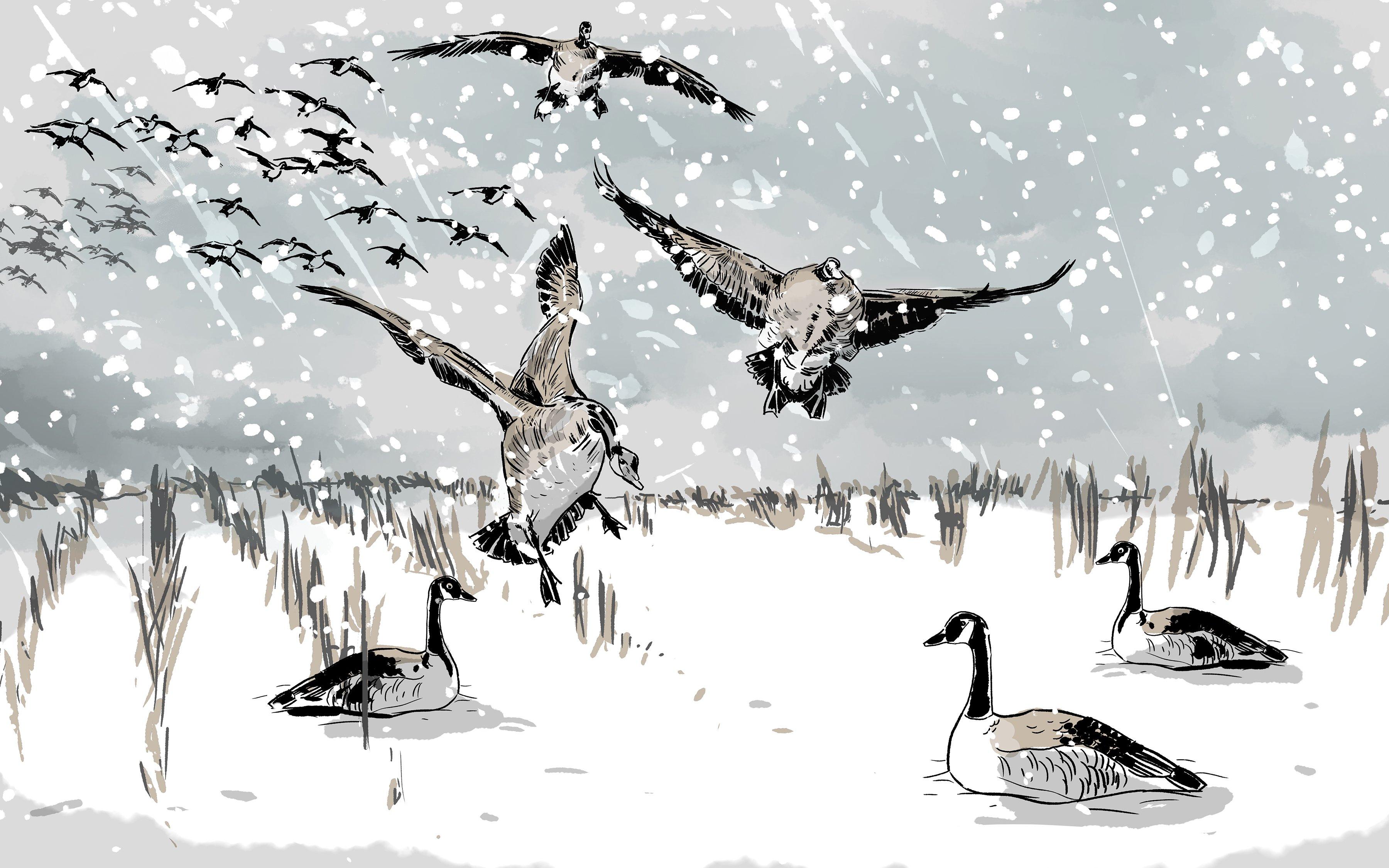White-out conditions and waves of ducks create an unforgettable day
We were running late, and I blamed the rock pile.
While glassing from the town road the previous night, that cobbled mound of stones had seemed so conspicuous — like a beacon marking the perfect setup spot for what promised to be a bang-up mallard and honker shoot in a vast beanfield. The plan seemed so basic: Find the rock pile before dawn, set out a modest spread, brush in the blinds and wait for daylight.
But we hadn't counted on the blizzard. Forecasters had called for some snow and a stiff breeze that day in northeastern South Dakota, but we awoke to sustained northwest winds of almost 50 mph and heavy snow that whipped sideways across the landscape. And because of the resulting whiteout conditions in the pre-dawn, we couldn't see the rock pile. In fact, we crisscrossed the field for an hour hoping to stumble across it, but we only encountered snowdrifts and stray beanstalks the combine had missed.
Finally, someone suggested the obvious: It's gonna be light soon. We'd better just set up.
Ready or not, the great prairie blizzard hunt was on.
A Plan and a Problem
Joe, Jim and I had hunted together many times, so our preparations went quickly. We'd only brought about three-dozen decoys, so it took minutes to throw out some shells and stake down the full-bodies in a loose U-shape. Then, at legal shooting time, we plopped our blinds out behind the spread, not bothering to decorate them with natural cover. They'd soon be covered with snow, anyway.
As we stepped into our layouts, two decoys broke loose and skidded across the field, driven by the blow. I set my gun inside the blind and jogged to retrieve them, securing them tighter in the ground. Someone shouted something, but I couldn't understand the words through the screaming gale. Then I glanced up to see scores of dark forms seemingly hovering still in the wind. Ducks. Or at least I figured they were ducks. More shouting indicated I needed to sprint back to my blind so the shooting could begin.
Jamming snow-coated boots into my already-white blind, I fumbled to find three shells and scanned the horizon. Birds streamed overhead nonstop, appearing like gray wraiths when they were almost in range. Some dipped lower to decoy, but many others beat wings to drive through the incessant wind. Most were mallards, as expected; big flocks bent on other destinations but smaller groups that set their wings to work our meager spread. Shots soon rang out, and we raced to collect the first greenheads. Then, smaller ducks zipped through, and Joe dropped a bird that had almost landed on his blind.
Greenwing, he said, almost laughing. Who'd have figured that?
But after tossing the pretty drake behind his blind, Joe discovered a problem. A shell was stuck in his Winchester, and with no tools handy, he'd have to disassemble the shotgun by hand. My fingers ached already. Watching Joe grasp and pull at that cold metal made them hurt more. But as birds pitched in, Jim and I didn't hesitate, figuring Joe would catch up soon.
After a few tense minutes, Joe's gun was back in the game, and he began putting it to use. By then, pintails had joined the mallards, and we picked off even numbers of each as the action continued. We soon had half a three-man limit, and the morning had just started.
Geese and a Surprise Guest
The skyline slowly brightened, and flocks of honkers began pouring off larger waters to the southeast in search of carbohydrate-rich grain. Many eschewed our small duck-only setup, but a few wanted the field badly and soon joined our piles. I attributed that to calling, but I'm not sure the birds even heard us through the wind. Snows sailed over high, probably fresh from North Dakota, but we didn't bother messing with them. The ducks and a few honkers sufficed.
Soon, we'd filled our sprig limits and had to focus on greenheads. And as the wind seemingly increased to hurricane levels, we began to limit our shots to birds hovering directly in front of us. Anything at otherwise decent ranges could flick its wings into the wind as we rose to shoot and swiftly be out of range. But the mallard train continued, so we were content to be picky.
Now and then, a few gaddies and wigeon drifted by, but few offered good shots. During a brief break in the action, however, a smaller bird bombed toward our rig and swept across the decoys. Instinctively, I swung and shot, dropping the duck in a spray of snow.
Ringneck, I shouted. What the heck?
Who shoots a diver during a field hunt? someone responded. Only me, I guess. But the handsome drake made a nice addition to the bag.
When we were six birds shy of a limit, we became increasingly choosy and waited for perfect opportunities. Meanwhile, huge flocks of pintails began to put on a show. They poured over our blinds, many in V formation straining against the blow — in range and probably aware of us yet unconcerned. For the next 30 minutes, I lost count of how many bulls we watched overhead. I'd never seen that many before, and I haven't since.
But we were getting cold and wet, and business called. Two solo greenheads soon hit the snow, and someone dropped another from a big flock. Another double soon followed, and we waited on the final duck. Time seemed to drag as my ears burned and I wiggled frozen toes to retain feeling. When the final drake pitched in and finished our day, I jumped from my blind and began high-fiving my buds and grabbing decoys.
The hunt had been unforgettable. But we faced a half-mile walk into a 50-mph wind through 6 inches of heavy snow — carrying guns, blinds, decoys, six ducks and a few geese apiece.
The Long Road Home
If nothing else, the torturous slog through that field warmed us up. I was drenched in perspiration when we finally reached the white lump where our truck was parked. Typically, I might have brushed snow and ice off my gear and clothing before stowing it, but I didn't bother that day. Everything was soaked or frozen. We'd let the heater at camp dry everything.
I eased slowly onto the northbound highway, knowing we'd have to creep back to camp to avoid the ditch. Within minutes, we were behind a county plow truck going about 25 mph. And we stayed there for the next hour.
The slow drive let us soak up the scene. The blizzard had given local farmers a day off from combining corn, so every café was jammed with mud-splattered trucks. Larger waters were awash with pounding waves, and spray continuously flew across the highway, further icing the road. Even small sloughs were cauldrons of whitecaps.
And ducks and geese flew everywhere. Some seemed destined for Nebraska or points south. Others darted low to find leeward shorelines and inlets to rest from the wind. And in an ultimate must-see lifetime waterfowl moment, a greenwing flew low across the highway and smacked directly into the plow, which sent the bird's lifeless form 30 feet into the air.
Later, warm and rested at camp, we learned that many hunters in the Dakotas had taken the day off. That wasn't a bad choice, of course. Larger waters would have been almost impossible to hunt. Even small stuff might have posed problems for decoys and dogs. We'd simply stumbled onto the perfect location for that situation. And we were giddy that we never considered staying at camp.
And Again
Scouting that afternoon wasn't possible, so we decided to try the field again the next morning. By dawn, the wind had ceased, and temperatures had plummeted into the teens. The snow had formed a firm crust, which made walking torturous. But we gave it a try. And we never saw a duck. Huge, high flocks of snows and blues told us a major migration had occurred.
We scratched out a few ducks at other spots that afternoon. And we had a good pheasant shoot, too. But as we headed east toward home the next day, iced-over trucks and wind-burned cheeks reminded us of the unique hunt we'd experienced — the day we fought the full force of a prairie blizzard and enjoyed a waterfowl spectacle we'd likely never top.
Click here for more Realtree waterfowl hunting content. And check us out on Facebook.








